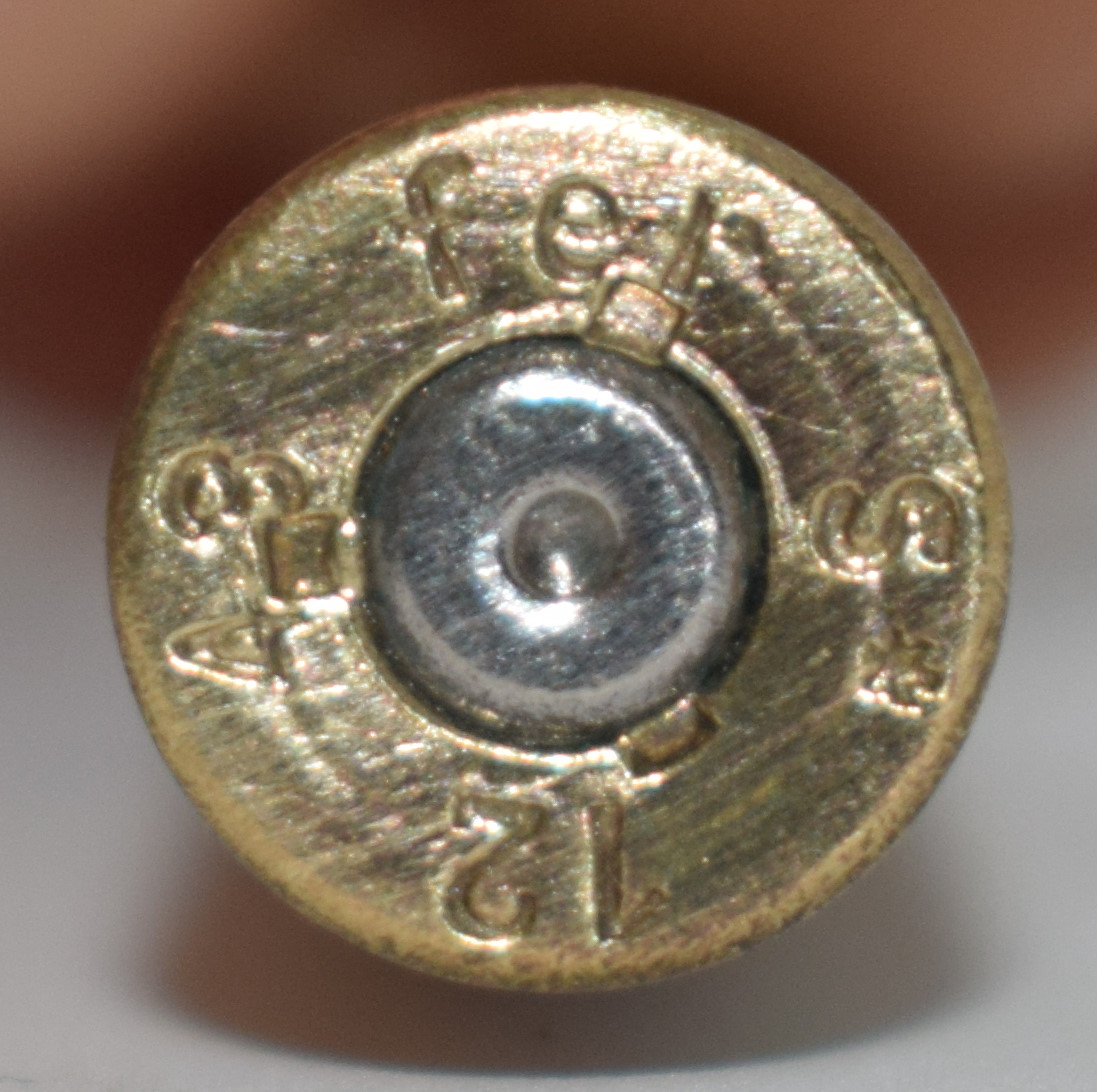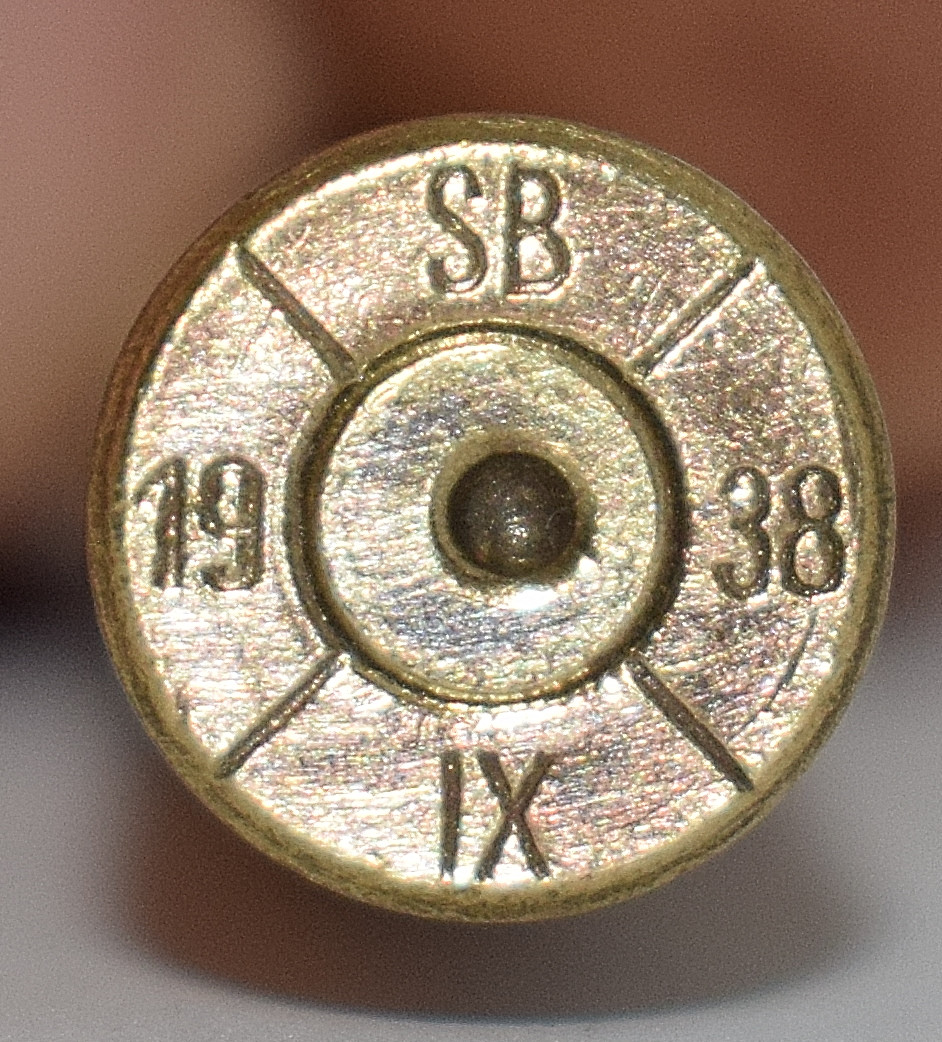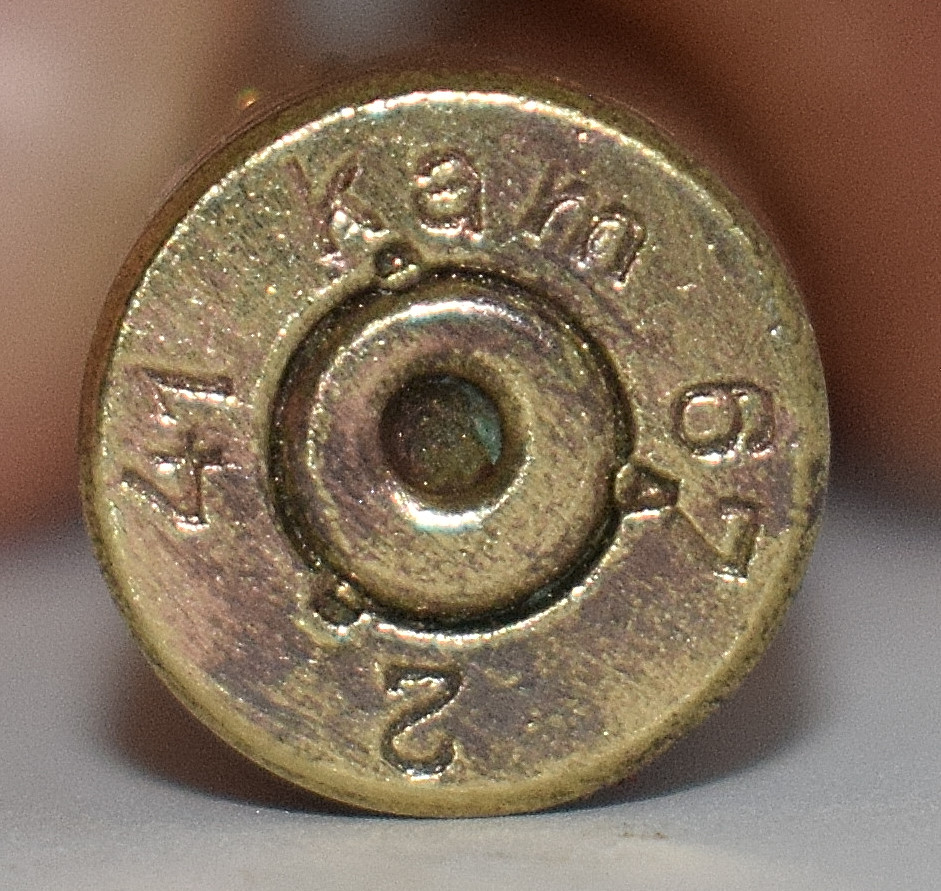Make a one-time donation
I don’t charge for viewing this website or downloading the content, but it does cost me money to host it! If you find the content useful, please feel free to help out with the costs 🙂 No pressure though…….
Or enter a custom amount
Your contribution is appreciated.
DonateThe German army used the 7.92mm cartridge extensively in WW2, with many of their front line smalls arms utilising the cartridge, as well as being used in the MGs of some aircraft of the Luftwaffe. Those weapons using this cartridge included the Fallschirmjägergewehr 42; Gewehr 41; Gewehr 43; Gewehr 98; Karabiner 98k; Maschinengewehr 08; MG 15; Maschinengewehr 30; Maschinengewehr 34; Maschinengewehr 42; MG 81………
The 7.92×57mm Mauser is a rimless bottle-necked rifle cartridge, produced by a number of different countries and first adopted by the German Empire in 1903-1905. It is such a versatile and effective cartridge that it is still in use today, being produced by factories in both Europe and the US.
Want to know more about cartridge case terminology and how to identify headstamps of other nation’s WW2 cartridges? Click here!
This article will concentrate on the headstamps of the WW2 cartridge cases, not only giving an explanation of the headstamp components, but also listing all the manufacturers, plating firms and steel producers recorded in the headstamp.
SCROLL TO THE BOTTOM IF YOU JUST WANT TO IDENTIFY A MANUFACTURER!
Early brass cased cartridge cases
The Treaty of Versailles severely limited the number of weapons and ammunition the Germans could produce, restricting the production of the 7.92×57 cartridge to one factory, Polte. This factory used the headstamp ‘P’ as a manufacturer identification mark and, in 1924 when the Germans began producing ammunition at other factories in secret, the ‘P’ prefix was retained. From 1926 until 1940, (with a few factories still using a P number into 1941), there were 34 distinct manufacturers of the 7.92×57. The headstamps for this period, (and indeed throughout the war), were made up of 4 distinct pieces of information.

At the 12 o’clock position is the manufacturer code, brass alloy info at 3 o’clock, lot number at 6 o’clock and year of manufacture at 9 o’clock.
The brass alloy code was simply either an ‘S’, (showing it is brass with 67% copper), or an ‘S*’ (72% copper). The star was either five or six pointed, but this is believed to just be a variation among manufacturers and doesn’t denote anything.




The lot number assigned to a manufacturing run could be found on anywhere between 180,000 and 3,500,000 cartridge cases, with the size of the lots increasing as the war progressed. It was purely used to identify a batch of cartridges should any problems arise with them during use.
Early steel cased cartridge cases
The second type of headstamp system used by the German factories identified copper-washed and lacquered steel cartridge cases. This system not only identified the steel mill used to manufacture the casing, but also the plating firm that applied the copper ‘wash’ (through electrolysis), and the precise make-up of the steel used. It was used from 1936 to 1940/41 before being replaced for the remainder of the war with a ‘universal’ system.

The steel information headstamp was made up of three components.
Roman numeral – The steel mill that manufactured the casing
Lower case letter(s) – Plating firm
Number – Steel composition
Examples of this system can be seen below.



Each lot was usually made up of 10,000kg of steel which was enough to manufacture around 750,000 cartridge cases. If any problems with quality were experienced during one manufacturing run, the steel would be mixed with other lots to complete the batch. It is therefore quite possible to find a headstamp with the manufacturer, lot and year the same, but the steel code different.
Mid to late war cartridge cases
The third and final system used by the Germans came in around 1940 and continued until the end of the war. It replaced the ‘P’ numbers with a two or three letter manufacturer code, and the complicated steel analysis stamp was replaced with something far simpler. The cartridges still carried ‘S*’ for brass, but now, instead of the roman numerals, letter and number, a simple ‘St’ or ‘St+’ was used. The ‘St’ headstamp simply stood for steel, with the ‘St+’ standing for improved strength steel.




In this third system, there were two additional pieces of information sometimes included in the headstamp. The first, a dash after the manufacturer code, showed the cartridge case had a single flash hole from the primer, and not the standard berdan 2 holes. The second, two opposing radial lines, indicated the case was made from bar stock rather than the usual flat stock.


Variations to this third system were sometimes used to differentiate between 2 factories of the same company. For instance, RWS, (Rheinisch-Westfälische Sprengstoff A.G., Werk Nürnberg-Stadeln), had a factory at Nürnberg and at Stadeln, They were differentiated between via the lot number, with one factory starting at lot 1, the other starting at lot 51 within any given year. In this way, an individual factory could be identified.
Another method for showing different factories was to use a dot after the manufacturer stamp, as can be seen below.

One final way of showing different factories of the same manufacturer was to put a bar above and below the Roman numerals in the earlier ‘P number’ headstamp method.
Variations
It is relatively well known that ‘SS’ stamped 7.92mm cartridges were made and stamped as such. I have no example to show you but the headstamp varied by carrying only three sets of info. Firstly was the manufacturer code, then the date (usually four digits), and finally the SS rune.
Other variations include those cartridges made outside of German during WW2. Of note are both Hungarian and Czechoslovakian factories.

Another variation seen is the use of the copper content of the alloy rather than the standard ‘S’.

Lastly, whilst not of German manufacture, (or any of its allies), below is shown a British manufactured 7.92mm cartridge. These were used in the Besa machine guns, found mounted in a number of British tanks during WW2.

With all the above information at hand, identifying the manufacturers is the final step. Below are lists of all the P codes, letter codes, Steel mills, plating companies and steel composition headstamps.
P CODES
P – Polte Armaturen-u. Maschinenfabrik A.G., Werk Magdeburg, Sachsen
Pak – Patr.-Zundh.-u. Metallwarenfabrik AG, vorm.. Sellier & Bellot, Werk Vlasim. CSSR
Pö – Metallwarenfabrik Treuenbritzen GmbH., Werk Sebaldushof
Pu – Borgsmüller Kreiensen-Hartz
Ps – Bofors (Sweden)
P14 – Waffenwerke Brünn A.G., Werk Povaszka Bystrica
P25 – Metallwarenfabrik Treuenbritzen GmbH, Werk Sebaldushof
P28 – DeutscheWaffen- u. Munitionsfabriken A.G., Werk Karlsruhe, Durlach
P67 – H. Uttendörffer, Munitionsfabrik, Nürnberg, Bayern
P69 – Patronen-, Zündh.- u. Metallwarenfabrik A.G., vorm. Sellier & Bellot, Schönebeck/Elbe
P90D – Bergmann Elektrizitätswerke A.G., Berlin-Wilhelmruh
P90 – Patronen-, Zündh.- u. Metallwarenfabrik A.G., vorm. Sellier & Bellot, Werk Vlasim, Prag
P94 – Kabel- u. Metallwerke Neumeyer A.G., Klingenhofstraße, 72, Nürnberg
P120 – Dynamit A.G., vormals Alfred Nobel & Co., Werk Hannover-Empelde
P128 – Wolf & Co. K.G., Walsrode/Hannover
P131 – Deutsche Waffen-u. Munitionsfabriken A.G., Werk Berlin-Borsigwalde
P132 – Draht-u. Metallwarenfabriken GmbH, Salzwedel, Sachsen
P151 – Rheinisch-Westfälische Sprengstoff A.G. (R.W.S.), Werk Stadeln bei Nürnberg
P154 – Polte Armaturen-u. Maschinenfabrik A.G., Werk Grüneberg, Nordbahn, Schlesien
P162 – Presswerk GmbH, Metgethen/Ostpreußen
P163 – Metallwarenfabrik Treuenbritzen GmbH, Werk Selterhof
P168 – Pulverfabrik A.G., Koln-Rottweil
P169 – Pulverfabrik Hasloch, Hasloch am Main
P181 – Hugo Schneider A.G., Lampenfabrik, Hugo Schneider Straße, 87, Leipzig O 5, Sachsen
P186 – Metallwerk Wolfenbüttel GmbH, Halchterstraße, 21, Wolfenbüttel
P198 – Metallwarenfabrik Treuenbritzen GmbH, Werk Röderhof, Belzig/Mark
P207 – Metallwerk Odertal GmbH, Odertal
P249 – Finower Industrie GmbH, Finow/Mark Brandenburg
P315 – Märkisches Walzwerk GmbH, Strausberg Bez. Postdam
P316 – Westfälische Metallindustrie A.G., Lippstadt, Westfalen
P334 – Mansfeld A.G., Metallwarenfabrik, Werk Rothenburg an der Saale
P340 – Metallwerke Silberhütte GmbH, St. Andreasberg i/Harz
P345 – Silva Metallwerke GmbH, Genthin (avu)
P346 – H. Huck, Metallwarenfabrik, Gostenhofer Hauptstraße, 61/63, Nürnberg W, Bavaria
P369 – Teuto Metallwerke GmbH, Klosterstraße, 29, Osnabrück, Hannover
P370 – Hugo Schneider A.G., Werk Berlin-Köpenick
P379 – Metallwarenfabrik Scharfenberg & Teubert GmbH, Breitungen-Werra, Thüringen
P398 – Theodor Bergmann & Co. K.G., Werk Velten
P399 – Theodor Bergmann & Co. K.G., Werk Bernau
P413 – Deutsche Waffen-u. Munitionsfabriken A.G., Lûbeck-Schlutup, Schleswig-Holstein
P442 – Zieh-und Stanzwerk GmbH, Schleusingen, Thüringen
P490 – Hugo Schneider A.G., Werk Altenburg
P491 – Metallwerk Wandhofen GmbH, Schwerte/Ruhr; Westfalen
P635 – Gustloff-Werke, Otto Eberhardt-Patronenfabrik, Hirtenberg Niederdonau
P797 – Hugo Schneider A.G., Werk Meuselwitz
HASAG – Hasag Eissen-u.. Metallvverke A.G., Werk Skarzysko-Kamienna
Rdf – Pulferfabrik Reinsdorf
LETTER CODES
ad – Patronen-, Zündh.-u. Metallwarenfabrik A.G. vormals Sellier & Bellot, Schönebeck/Elbe
ak – Munitionsfabriken vormals Sellier u. Bellot, Werk Vlasim, Prag
am – Gustloff Werke, Otto Eberhardt – Patronenfabrik, Hirtenberg, Niederdonau
asb – Deutsche Waffen-u. Munitionsfabriken A.G., Berlin-Borsigwalde
arl – Bergmann Elektrizitätswerke A.G., Berlin-Wilhelmsruh
aux – Polte Armaturen und Maschinenfabrik A.G., Werk Magdeburg, Sachsen
auy – Polte Armaturen und Maschinenfabrik A.G., Werk Grüneberg, Schlesien
avu – Silva Metallwerke GmbH, Werk Genthin
ay – Alois Pirkl, Elektrotechn.- Fabrik, Reichenberg
bne – Metallwerke Odertal GmbH, Odertal
bnf – Metallwerke Wolfenbüttel GmbH., Wolfenbüttel
byw – Johannes Schäfer, Stettiner Schraubenwerk, Stettin
cdo – Theodor Bergmann & Co., Waffen- u. Munitionsfabrik K.G., Werk Velten
cdp – Theodor Bergmann & Co., Waffen- u. Munitionsfabrik K.G., Werk Bernau
cg – Finower Industrie GmbH, Finow/Mark, Brandenburg
ch – Fabrique Nationale d’armes de guerre S.A., Herstal/Liège (Lüttich/Belgien)
dnb – Borck & Goldschmidt Mechanische Werkstätten, Berlin
dnf – Rheinisch-Westfälische Sprengstoff A.G., Werk Nürnberg-Stadeln
dom – Westfälische Metall-Industrie A.G., Lippstadt, Westfalen
dou – Waffenwerke Brünn A.G., Werk Povaszka Bystrica
eba – Metallwarenfabrik Scharfenberg & Teubert GmbH, Breitungen-Werra, Thüringen
edq – Deutsche Waffen-u. Munitionsfabriken A.G., Wesloerstraße, Lübeck-Schlutup
eej – Märkisches Walzwerk GmbH, Straussberg bezirk Potsdam
eey – Metallwarenfabrik Treuenbritzen GmbH, Werk Röderhof
emp – Dynamit A.G., vormals Alfred Nobel & Co, Werk Empelde bei Hannover
eom – H. Huck, Metallwarenfabrik, Nürnberg
fb – Mansfeld A.G., Metallwarenfabrik, Werk Rothenburg/Saale
fer – Metallwerke Wandhofen GmbH, Schwerte/Ruhr, Westfalen
fva – Draht-u. Metallwarenfabrik GmbH, Salzwedel, Sachsen
has – Pulverfabrik Hasloch, Hasloch am Main
hhw – Metallwerke Silberhütte GmbH, St-Andreasberg im Harz
hla – Metallwarenfabrik Treuenbritzen GmbH, Werk Sebaldushof
hlb – Metallwarenfabrik Treuenbritzen GmbH, Werk Selterhof
hlc – Zieh-u. Stanzwerke GmbH, Schleusingen, Thüringen
hrn – Presswerke GmbH, Metgethen, Ostpreußen
kam – Hasag, Eisen-u. Metallwerke GmbH., Werk Skarzysko Kamienna, Polen
lpk – Servotechna A.G., Prag
nbe – Hasag, Eisen-u. Metallwerke GmbH, Werk Apparatebau Tschenstochau, Polen
oa – William Prym, Metallhalbfabrikate, Stolberg, Rheinland
oxo – Teuto-Metallwerke GmbH, Osnabrück, Hannover
pae – Unknown but possibly Hasag Eissen-u, Metallwerke GmbH., Werk Skarzysko Kamienna, Polen
pmt – Kabel- u. Metallwerke Neumeyer A.G. Nürnberg, Werk München
SB – Patr. -Zundh. -u, Metellwarenfabrik AG, vorm. Sellier & Bellot, Vlasim,Czechoslovakia
SMI – Societa Metallurgica Italien
tko – DWM, Werk Lübeck-Schlutup
va – Kabel-u. Metallwerke Neumeyer A.G., Nürnberg
wa – Hugo Schneider A.G. Abteilung Lampenfabrikation, Leipzig
wb – Hugo Schneider A.G., Werk Berlin-Köpenick
wc – Hugo Schneider A.G., Werk Meuselwitch, Thüringen
wg – Hugo Schneider A.G., Werk Altenburg, Altenburg, Thüringen
Z – Waffenwerke Brunn A.G., Povazska, Werk Povazska Bystrica, CSSR (Hungary)
STEEL MILL CODES
I – Krupp ACL, Essen
II – Vereinigte Oberschiesische Huttenwerke. Gleiwitz
III – Mannesmann, Dusseldorf
IV – Hosch A.G., Dortmund
V – Eisen and Huttenwerke, Bochum
VI – Rheinmetall-Borsig Dusseldorf
VII – Bochumer Verein fur Gusstahlfabrikation Bochum
VIII – Dortmund-Horder Huttenverein. Werk Union Dortmund
IX – August-Thyssen-Hutte, Hamborn
X – Klockner-Vilerke AG.,Marienwerke Osnabruck
XI – Klockner-Vilerke A.G_, Haspe-Westf
XII – Mitteldeutsche Stahlwerke, Werk Henningsdorf
XIII – Mitteldeutsche Stahlwerke Werk Riesa
XIV – Eisenhlittenwerke, Male Thala
XV – unknown
XVI – Huttenwerke Siegerland
XVII – Maximilianshutte abt Unterwellenborn
XVIII – Maximilianshutte, abt SulzbachiRosenberg
XIX – unknown
XX – unknown
XXI – unknown
XXII – unknown
XXIII – unknown
XXIV – unknown
Other plants
Stahlwerk Dahlen, Freiberg/Sachsen Steel for Polte case (P 1 28) St-cu 120′
Eisen-HOttenwerk, Berlin
Gutehoffnungsheate, Oberhausen
Thyssen-Rheinstahl, Werk Hamborn
Vereinigte Oberschlesische Huttewerke Werk Zawatzki/Andreashutte
Ruhrstahl A.G., Werk Henrichshutte, Hattingen
Mannesmann-Rohrenwerke, Gelsenkirchen
PLATING COMPANY CODES
a, az – Verein. Deutsche Metallwarke, Werk Altena/Westf_
b – Hindrichs-Auffermann AG :Walz– und Plattierwerk Wupperthal/Oberbarmen
ba – Sundwiger Messingwerk vorm_ Gebr. V.d. Becke Sundwig/VVestf.
bb – A Laue & Co Berlin-Reinickendorf
bc – Kupfer und Messingwerke Becker & Co_ Langenberg/Rhld
bd – EA_ Lange, Metallwarke„ abt Bodenbach/Sudeten
be – Berndorfer Metallwarenfabrik Artur Krupp BerndortiNiederdonau
c, ca – Verein._ Deutsche Nickelwerke Witte & Co_ Werk Schwerte/Ruhr
d – Verein„ Deutsche Nickelwarke Witte & Co_ Wert Labant/Oberschl
e – Trierer Walzwerk, Trier
eh – Trierer Walzwerk„ Werk Burg/Magdeburg
f, fa – Manzfeld AG f, Bergbau und Huttenbetrieb„ Hettstedt/Harz
g, ga – Hirsch Kupfer und Messingwerke, Werk Finnow/Mark
h – Wielandwerke Metallhalbfabrikate„ Ulm/Donau
i = j – R u G.. Schmole, Metallwerke, Manden/Westf„
k – Gerhardi & Cie, Metallw..fabrik and Walzwerk Ludenschaid/Westf
l – Durener Metallwarke, Werk Duren
m, ma – F.A. Lange, Neusilberfabrikate .aue/Sachsen
n, na – Westfalische Kupfer and Messingwerke. LadenscleidiNestf,
o – Eduard Hueck, Metallwarenfabrik, Ludenscheid/Westf
p – Stolberger Metallwarke„ von Asten„ Lynen & Schleicher Stolberg
q – William Prym, Metallhalbfabrikate, StallbergIRhid.
r, ra – Dt Messiagwerke Carl Eveking AG Berlin-Niederschoneweide
s – Bergrnann-Elektrizitatswerke AG„ Berlin–Wilhelmsruh
t – Durener Metallwerke, Werk Berlin-Borsigwalde
u – Osnabrucker Kupfer und Drahtwerke Osnabruck
v – Kaabel und Metalwerke Neumeyer, Nurnberg
w – Hugo Schneider AG„ Leipzig
x, xa – Ludenscheider Metalwerke Busch-Jager. Ludenscheid
y – Sachsische Metallwarenfabrik August Wellner Sohne, Aue/Sa
z – Kupferwerk Ilsenburg, llsenburg/Harz
STEEL COMPOSITION CODES
1 C : 0,15 – 0,22 % / Mn : 0,4 % / Si : 0,12 % / P : 0,03 % / S : 0,03 %
2 C : 0,08 – 0,12 % / Mn : 0,4 % / Si : 0,12 % / P : 0,03 % / S : 0,03 %
3 unknown
4 unknown
6 unknown
8 unknown
9 unknown
10 unknown
11 unknown
12 unknown
15 unknown
17 C : 0,17 – 0,22 % / Mn : 0,4 % / Al : 0,1 % / P : 0,03 % / S : 0,03 %
Al : aluminum ; C : carbon ; Mn : manganese ; P : phosphorus ; S : sulphur ; Si : silicon
(Pic below is just for when I post links to this blog! It shows this as the preview. Ha!)

Hi Stephen, I’ve recently subscribed to your posts and wonder if you could help. I live on the North Wales coast (Dyffryn Ardudwy), the local beach was a ww2 air gunnery range used by the RAF and USAAF, aircraft would be based at nearby llanbedr. With a metal detector it is fairly easy to find both 303 and 50 cal cartridges and heads. I’ve recently found bren fired cartridges ww2 dated, 2″ mortar fins and 9 mm heads all infantry weapons so some infantry training took place on the same site. My main query is regarding the discovery of a 6.5mm head, a local chap who is also a ‘detectorist’ tells me he has found hundreds of these smaller heads over the years . I am thinking that this is probably of Italian origin,pos breda HMG ?. A friend has come across a brief mention of captured Italian ammo being used in live fire training. Just south of Dyffryn is Barmouth, where in ww2 the Royal Marines had several training camps mainly relating to landing craft training. I have not yet managed to find any cartridges that fit a 6.5mm round . Have you ever come across captured Italian ammo being used for training in the UK ?. I have known the area for many years but only moved here to live last autumn so am still discovering the wartime history of this part of North Wales. I would be very grateful for any ideas or information kind regards….Mike
LikeLike
Hi Mike. Thanks for your post. Your site sounds very interesting. Please use the contact page to send me a message and we’ll go from there!
LikeLike
During the early years of WW1, the British purchased a large number of 6.5mm Japanese rifles to equip the navy since all Lee Enfields were taken to arm ground troops. Kynoch even manufactured rounds for these weapons. Eventually, all these rifles and ammunition went to arm the Russians. It is possible that is the source of the 6.5 projectiles you have discovered.
LikeLike
Hi
I have a box full of my grandfathers old ammo. He brought it back from germany.
Its stamped 12 34 P S*
The star has 6 points
Can you help identify?
Thanks
LikeLike
Please use the Contact page to drop me an email and you will be able to send pics once I reply.
LikeLike
Can anybody give ne information about the hersteller P46
1936.
I found a huge amount of these k98 cartridges in the sea in mint condition.
Unused with heads in the shells
Kind regards
Marc
LikeLike
Hi Mr. Stephen, I found a cartridge near where I live in Germany. It is oxidized like many of the others I have found. The problem is that it has no stamp at all. Have you ever heard of this happening? In our area we find WW2 and post-war training things. We’ve found German, French, USA, and British cartridges if that helps. The cartridge is 30 caliber and the bullet end is oxidized a lot. I hope you can help.
Sincerely,
Ronan
Youtube channel “Way Into Adventures”
LikeLike
Great website, very helpful!
LikeLike